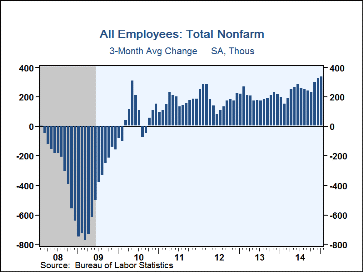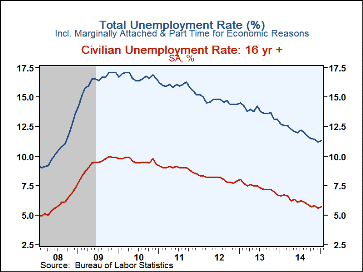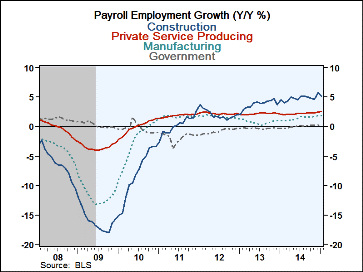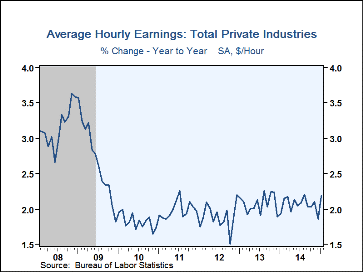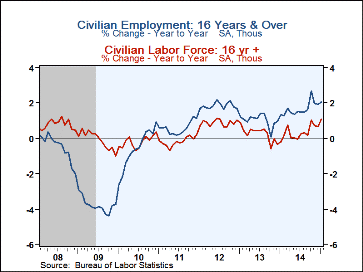 Global| Feb 06 2015
Global| Feb 06 2015U.S. Payroll Jobs & Earnings Grow More Than Expected; Unemployment Rate Nudges Higher
by:Tom Moeller
|in:Economy in Brief
Summary
Improvement in the job market is strengthening. Payroll employment increased 257,000 (2.3% y/y) during January following upwardly revised gains of 329,000 and 423,000 during the prior two months. The average change in payrolls during [...]
Improvement in the job market is strengthening. Payroll employment increased 257,000 (2.3% y/y) during January following upwardly revised gains of 329,000 and 423,000 during the prior two months. The average change in payrolls during the last three months of 336,000 was the strongest since November 1997. The latest rise compared to expectations for 230,000 in the Action Economics Forecast Survey. Moderate growth in payrolls was evident across sectors. It was accompanied by a 0.5% rebound in average hourly earnings that followed an unrevised 0.2% decline. A 0.3% gain was expected. The unemployment rate ticked up to 5.7% versus expectations for stability at 5.6%. The overall unemployment rate, including marginally attached workers and those employed part-time for economic reasons, inched up to 11.3%. The payroll employment figures were revised due to annual benchmark revisions.
From the payroll survey of the job market, the surprising rise last month reflected a manufacturing sector increase of 22,000. It left the average three-month gain strengthening by 31,000. Construction jobs also increased enough (39,000) to pull three-month growth to 38,000, its best since early last year. Private service producing jobs improved 209,000, leaving the 3-month gain at 265,000. Jobs in health care & social assistance increased 49,700 (2.6% y/y) and retail trade jobs strengthened 45,900 (1.9% y/y). Professional & business services employment rose 39,000 (3.8% y/y) but temporary jobs fell 4,000 (+6.7% y/y), the first decline in 12 months. Leisure & hospitality employment gained 37,000 (3.3% y/y). Financial activities hiring rose 26,000 (2.0% y/y) and information sector employment improved 6,000 (1.7% y/y). Government sector employment offset these gains with a 10,000 worker fall (+0.4% y/y), the first decline in twelve months. Federal government employment declined 6,000 (+0.2% y/y), state government jobs were off 3,000 (+0.5% y/y) and local government hiring inched 1,000 lower (+0.4% y/y).
The length of the average workweek held steady at a cycle-high of 34.6 hours, where it's been for four months. Overtime work dipped to a still-strong 3.5 hours. The index of aggregate hours worked (employment times hours) rose 0.3% (3.3% y/y) and started this quarter 2.0% (AR) above Q4, which rose 4.1% from Q3.
Average hourly earnings rebounded 0.5% (2.2% y/y) after a 0.2% decline. The annual increase was its best since August. Strength in professional & business professions and education & health services led the gain.
From the household employment survey, the unemployment rate's rise to 5.7% reflected a 759,000 increase (2.1% y/y) in employment and a strengthened 1.051 million gain (1.1% y/y) in the labor force. An improved job market is prompting a return of workers to the job market. The labor force participation rate increased m/m to 62.9%, its highest level since November. Moreover, the rate's ongoing decline since the 1997-2000 average of 67.1% stabilized as of Q4 2013. Growth in the number of individuals not in the labor force slowed to 1.2% y/y from 3.5% early in 2011.
The average duration of unemployment fell to 32.3 weeks from the 2011 high of 40.6 weeks. The median duration dropped to 13.4 weeks from a 2011 high of 22.4 weeks.
The unemployment rate for those without a high school diploma slipped to 8.5% while high school gradates with no college experienced 5.4% joblessness. For individuals with less than a bachelors degree the unemployment rate of 5.2% compared to 2.8% for college graduates.
| Employment: (M/M Chg., 000s) | Jan | Dec | Nov | Y/Y | 2014 | 2013 | 2012 |
|---|---|---|---|---|---|---|---|
| Payroll Employment | 257 | 329 | 423 | 2.3% | 1.9% | 1.7% | 1.7% |
| Previous | -- | 252 | 353 | -- | -- | -- | -- |
| Manufacturing | 22 | 26 | 45 | 1.9 | 1.4 | 0.8 | 1.7 |
| Construction | 39 | 44 | 30 | 5.1 | 4.8 | 3.7 | 2.1 |
| Private Service Producing | 209 | 247 | 338 | 2.6 | 2.2 | 2.2 | |
| Government | -10 | 9 | 9 | 0.4 | 0.0 | -0.3 | -0.8 |
| Average Weekly Hours - Private Sector | 34.6 | 34.6 | 34.6 | 34.4 (Jan.'14) |
34.5 | 34.5 | 34.4 |
| Private Sector Average Hourly Earnings (%) | 0.5 | -0.2 | 0.4 | 2.2 | 2.1 | 2.1 | 1.9 |
| Unemployment Rate (%) | 5.7 | 5.6 | 5.8 | 6.6 (Jan.'14) |
6.1 | 7.4 | 8.1 |
Tom Moeller
AuthorMore in Author Profile »Prior to joining Haver Analytics in 2000, Mr. Moeller worked as the Economist at Chancellor Capital Management from 1985 to 1999. There, he developed comprehensive economic forecasts and interpreted economic data for equity and fixed income portfolio managers. Also at Chancellor, Mr. Moeller worked as an equity analyst and was responsible for researching and rating companies in the economically sensitive automobile and housing industries for investment in Chancellor’s equity portfolio. Prior to joining Chancellor, Mr. Moeller was an Economist at Citibank from 1979 to 1984. He also analyzed pricing behavior in the metals industry for the Council on Wage and Price Stability in Washington, D.C. In 1999, Mr. Moeller received the award for most accurate forecast from the Forecasters' Club of New York. From 1990 to 1992 he was President of the New York Association for Business Economists. Mr. Moeller earned an M.B.A. in Finance from Fordham University, where he graduated in 1987. He holds a Bachelor of Arts in Economics from George Washington University.


